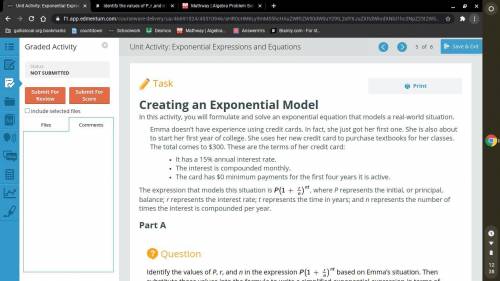KathyRayG7456
07.01.2021 •
Mathematics
Part A
Question
Identify the values of P, r, and n in the expression p(1+r/n)^nt based on Emma’s situation. Then substitute those values into the formula to write a simplified exponential expression in terms of time.
Replace the variables a, b, and c to write the expression.
Part B
Question
Since the card has $0 minimum payments for the first 4 years it is active, Emma wonders how much it will cost her if she doesn't pay off the $300 balance until after college. How much will she owe in 4 years?
Type the correct response in the box. Use numerals instead of words. Round your answer to the nearest dollar.
In 4 years, Emma will owe about $ ???
Part C
Question
Emma also wonders how long it will take her balance of $300 to reach $450, assuming she doesn’t make any payments toward it. Write the equation to represent the situation, and solve it using the inverse relationship between exponential and logarithmic expressions.
Type the correct response in the box. Use numerals instead of words. Round your answer to the nearest tenth.
It will take about ?????
years for Emma’s balance to reach $450.
Part D
Question
Emma notices that since her credit card balance compounds monthly, she is charged more than 15% of her initial loan amount in interest each year. She wants to know how much she would pay if the card were compounded annually at a rate of 15%. Which expression could Emma use to evaluate her balance with an annual compounding interest rate?
OPTIONS
A- 300(1.015)^12t
B- 300(1.15)^t
C- 300(1.0125)^t
D- 300(1.15)^12t
Part E
Question
How would the situation change if the interest on Emma’s credit card were compounded annually rather than monthly, and she didn’t make any payments toward the balance?
Select the correct answer from each drop-down menu.
After 4 years, Emma would owe approximately $ (435, 545, 525, 480) for her original purchase of $300.
It would take around (2.5, 2.7, 2.9, 3.1) years for her balance to increase from $300 to $450.

Solved
Show answers
More tips
- G Goods and services How to Choose a Humidifier? Helpful Tips and Recommendations...
- W Work and Career What is the Most In-Demand Profession in the Modern World?...
- A Auto and Moto How Can Parking Sensors Help Drivers?...
- H Health and Medicine What is the Normal Blood Sugar Level in a Healthy Person?...
- F Food and Cooking Red Caviar: How to Choose the Best?...
- C Computers and Internet Clearing Cache: How to Speed Up Your Browser...
- S Style and Beauty How are artificial nails removed?...
- S Style and Beauty Secrets of Tying a Pareo: 5 Ways...
- F Food and Cooking Everything You Need to Know About Pasta...
Answers on questions: Mathematics
- M Mathematics MAJESI DRAGO GOLD ION Marian hizo cinco llamaks telefonice más esta semana que la semena pasada Expresin algebraico THANK STORI DA Marian hizo cinco llamadas telefónicas...
- M Mathematics The diagonals of a quadrilateral bisect each other at right angles. What is the quadrilateral best described as? (a) parallelogram(b) kite(c) rhombus(d) trapeziumplease...
- S Social Studies Because research in the united states has demonstrated that adolescents are not very respectful to the elderly, sara concludes that all adolescents everywhere in the...
- M Mathematics What is the slope of a line parallel to the line whose equation is 5x + y = -9. Fully simplify your answer....
- E English Copy and complete the sentences with the Past Simple form of the verbs below. not enjoy • put • learn • not know • not read • meet • take • not build 1. Eric the answer...
- M Mathematics Can someone please help meee...
- E English The influence of latin on the u.s. constitution is most easily discernible in a.) grammatical structure b.) certain words/phrases c.) punctuation d.) capitalization...

Ответ:
Step-by-step explanation:
1. ENCUENTRA UN DENOMINADOR COMUN
Los denominadores que nos dan son: 4, 2, 5, y 3
Encuentra un numero que es comun cuando multiplicas, seria 60.
2. MULTIPLICA EL NOMINADOR POR LO QUE MULTIPLICASTE EL DOMINADOR
Carne=
Arroz=
Fruta=
Papa=
3. SUMA LAS FRACIONES
Ahora que tienen el mismo denominador, puedes sumar las fraciones